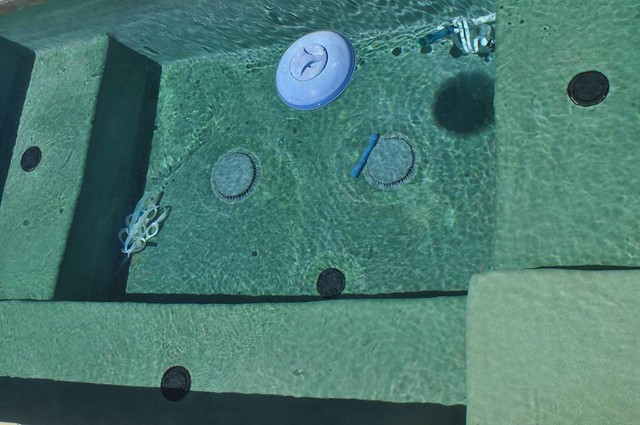Re: Orenda PR-10000
chem geek said:
70% concentration (by weight) of lanthanum chloride in the PR-10000 product ... added hydrochloric acid ... I don't believe the PR-10000 contains any clarifier
Hi Richard & Jason,
Thanks for taking the time to separate (Jason) and answer the question (Richard).
I love how Chem Geek thinks, in that he long ago deduced Lanthanum Chloride was the key inorganic phosphate (orthophosphate) flocculating ingredient based on LaCl3 toxicity hints in the
Orenda PR-10000 MSDS.
Even though my free chlorine (FC) is usually at least 7.5% above my cyanuric acid (CYA) level (I need to have it tested again though), when I brush the walls of my ~40K gallon pool (which is 60 feet long so there is a lot of wall) I can see a light coating of greenish-gray dust billow up lightly behind the wire brush at predictable spots. Not much, one or two brush strokes, and it's just a light cloud dispersing at the bottom of the pool but enough for me to wonder every day why the chlorine isn't doing the BBB thing. [Note: My PR2000 self-cleaning system needs the 9-port water valve heads rebuilt - so that isn't helping matters any. Unfortunately, I haven't ever done the chlorine demand test, which I need to do for more data.]
As a side note, well before I had read that the phosphates aren't the
real problem - in the past - I had used cupric algaecides from Lowes - which, incidentally, stained the white calcium deposits covering the pool walls from my hard well water with a very lovely greenish-blue relatively even tinge - so - I learned, first hand, about side effects on almost anything poured in the pool - in this case, a fortuitous coloring of the otherwise-dark-gray walls.

Given the persistence of this light algae covering, which I've tentatively attributed to three key factors (micro-sheltering on the calcium-coated walls, and a ready source of clearly visible green algae in a pond only a hundred feet upwind, coupled with Silicon Valley sunlight all day like you can't believe as there is no shade in sight), I'm going to have the phosphates tested at Leslies but they're generally high enough that the pool stores predictably try to sell me on their magic miracle cures. As always, my gut reaction is to look at the ingredients, and, as is typical with the miracle cures, they don't say. So, it was with glee that I found Chem Geek's threads explaining
how the Orenda PR-10000 worked (LaCl3 apparently precipitates the inorganic orthophosphates into Lanthanum Phosphate, which is then filtered out by the filtering system).
Reading the reference from Richard above, I'm impressed even he, the Chem Geek Logic Meister, brought his 3,000 ppb orthophosphate level down to 5% of that in his tests of the product.
Intrigued about running my own test, I googled and found various
Lanthanum Chloride solutions &
reagent grade Lanthanum Chloride, &
anhydrous Lanthanum chloride heptahydrates - and I started wondering how much of those one would put in a pool (per 10,000 gallons) so that I could calculate effective costs comparisons of Lanthanum Chloride versus the pool-store PR-10000 solution (which Chem Geek kindly calculated to be roughly around $3 for every 1,000 ppb in 10,000 gallons).
Given Richard fleshed out the PR-10000 economics, at this point, I guess my goal is to understand:
Q1: Does it matter which chemical-grade Lanthanum Chloride I buy for my experiment?
Q2: How much of that LaCl3 (solid or solution) should I use per 10,000 gallons for a 1,000 ppb flocculation?
Q3: How does that amount compare, in cost, to PR-10000 for the same effect?
chem geek said:
one quart will remove 10,000 ppb phosphates in 10,000 gallons... = 3.985 moles, = 977 grams of lanthanum chloride in one quart of PR-10000
Assuming scalable calculations of a 10,000 gallon pool, and a simple 1,000 ppb reduction goal, does that mean that, if I buy the solid LaCl3 (at roughly $1/gram), it looks like it would take 1/10th of the 977 grams of LaCl3, or roughly 100 grams of Lanthanum Chloride, to reduce orthophosphates by 1,000 ppb?
If so, the cost of reagent-grade Lanthanum Chloride appears to be prohibitive, at about $100 to reduce a 10,000 gallon pool by 1,000 ppb phosphates (if I followed Richard's math properly).



